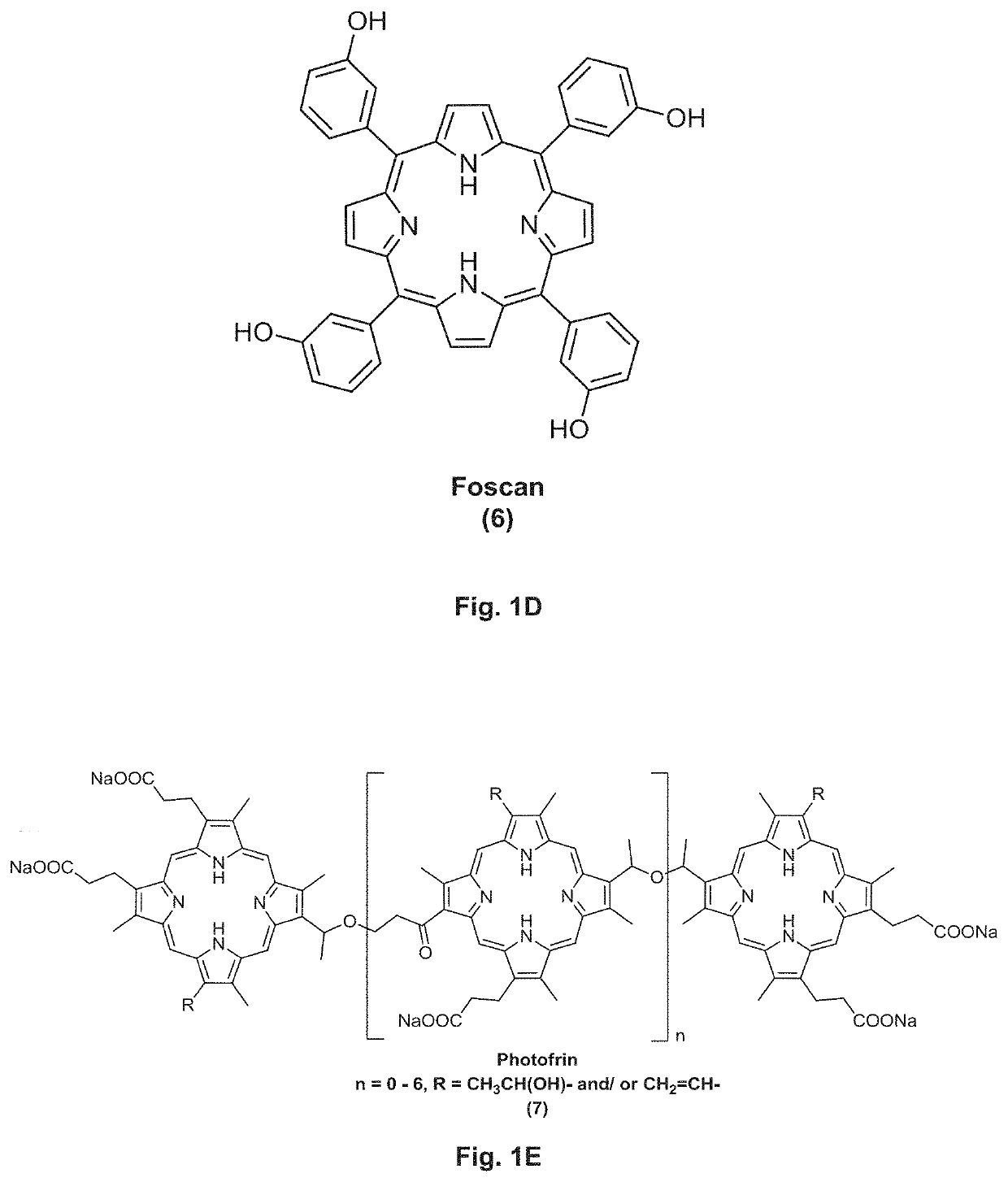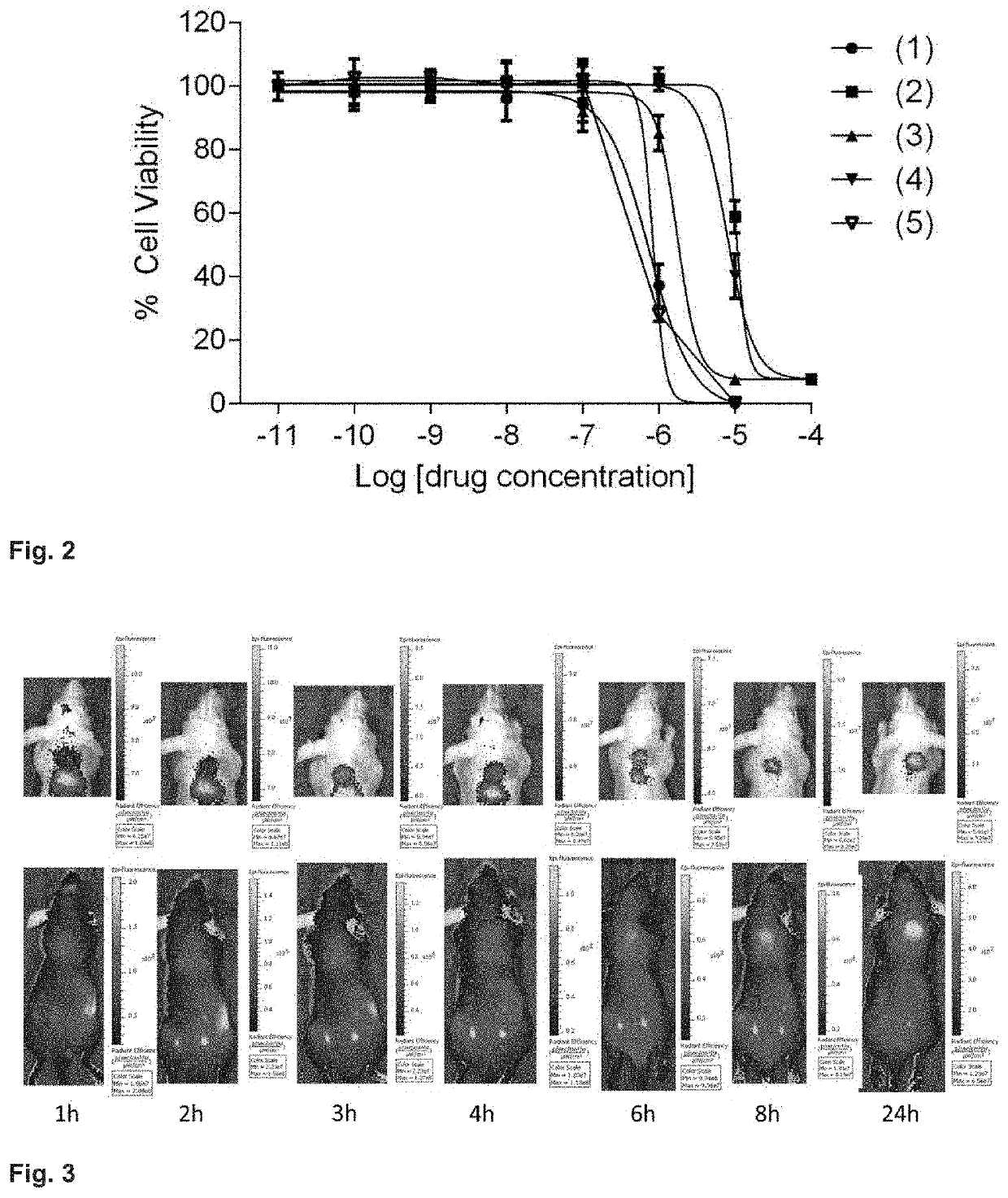Synthesis and composition of photodynamic therapeutic agents for the targeted treatment of cancer
a cancer and photodynamic therapy technology, applied in the field of synthesis and composition of photodynamic therapy agents for the targeted treatment of cancer, can solve the problems of patients often declining these therapies, significant risk of disease recurrence or even death, and none of these therapies are highly effective against metastatic diseas
- Summary
- Abstract
- Description
- Claims
- Application Information
AI Technical Summary
Benefits of technology
Problems solved by technology
Method used
Image
Examples
example 1
[0192]In the present example, the inventors performed a preclinical evaluation of commercially available non-targeted PDT agents or similar agents that are currently in clinical trials. The objective of the study was two-fold. Firstly, the objective was to evaluate photodynamic therapeutic efficacy of commercially available photosensitizes in cancer cells and secondly to evaluate photodynamic therapeutic efficacy of commercially available photosensitizers in cancer cells in tumor xenograft mouse models.
[0193]Synthesis of Tookad and its Analogues
[0194]Aqueous paste of Rhodobacter sphaeroides (150 g) was suspended in methanol (2.2 L) and argon was bubbled through the green suspension while stirring in the dark for 14 h. The suspension was filtered through the sintered glass funnel and the residue was washed with methanol until the filtrate was almost colorless. Filtrate was evaporated on rotary evaporator and dried under high vacuum to obtain crude bacteriochlorophyll-a (8) as dark gr...
example 2
cal Evaluation of Mitochondrial-Targeted Modified PDT Agents
[0206]In this example the objective was to modify BPheid-a to target mitochondria by conjugating to lipophilic cationic molecule or cationic peptides or molecule binds selectively to a target within mitochondria; to evaluate photodynamic therapeutic efficacy of mitochondrial targeting modified BPheid-a analogues in cancer cells; and to evaluate in vivo whole body imaging ability and PDT efficacy in mice bearing tumor xenografts for most active molecules in cell culture.
(a) Synthesis of Selected Modified Bpheid-a Analogues
[0207]Hydrazine (10.2 uL, 0.33 mmol, 10 equiv) was added to the solution of BPheid-a (1) (20 mg, 0.033 mmol, 1 equiv) or tookad (2) in dimethylformamide (3.3 mL). The reaction mixture is degassed with argon for 5 minutes and stirred at 23° C. for 3 h under argon. The reaction was purified by preparative HPLC using C18 column to obtain compound (24) or (25) as a dark brown solid.
[0208]Diisopropylethylamine (...
example 3
cal Evaluation of Nucleus-Targeted PDT Agents
[0228]The objective of this example was to modify BPheid-a to target the nucleus by conjugating to DNA binding agents, DNA alkylating agents, and the like to evaluate photodynamic therapeutic efficacy of nucleus-targeted modified BPheid-a analogues in cancer cells and to evaluate in vivo whole body imaging ability and PDT efficacy in mice bearing tumor xenografts for most active molecules in cell culture
[0229]Diisopropylethylamine (120 uL, 0.691 mmol) was added to a solution of N10-Methyl-4-amino-4-deoxypteroic acid (75 mg, 0.23 mmol), HATU (88 mg, 0.23 mmol) in DMF (5 mL) and stirred at 23° C. for 15 minutes (solution A). In another flask Compound (32-a) (47 mg, 0.23 mmol) was dissolved in DMSO (5 mL) and added Diisopropylethylamine (120 uL, 0.691 mmol) (Solution B). Solution B was added to solution A via cannula and stirred the content for 1 h. Upon completion the reaction mixture was purified by preparative HPLC using C18 column. (2-ca...
PUM
 Login to View More
Login to View More Abstract
Description
Claims
Application Information
 Login to View More
Login to View More - R&D
- Intellectual Property
- Life Sciences
- Materials
- Tech Scout
- Unparalleled Data Quality
- Higher Quality Content
- 60% Fewer Hallucinations
Browse by: Latest US Patents, China's latest patents, Technical Efficacy Thesaurus, Application Domain, Technology Topic, Popular Technical Reports.
© 2025 PatSnap. All rights reserved.Legal|Privacy policy|Modern Slavery Act Transparency Statement|Sitemap|About US| Contact US: help@patsnap.com



